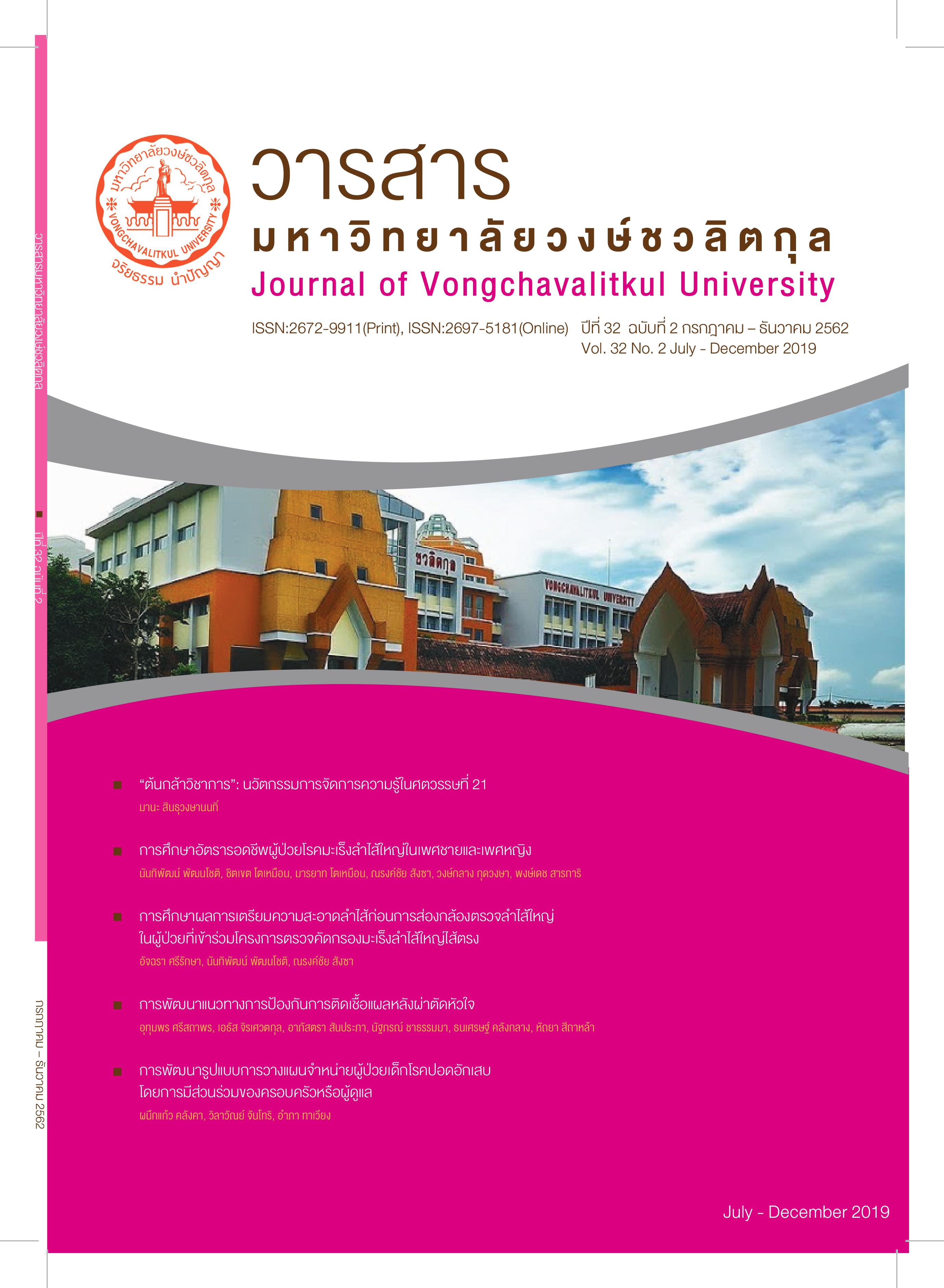A Development of Discharge Planning Model for Pediatric Patients with Pneumonia Using Family and Caregiver Participation
Main Article Content
Abstract
Objective: of this study was to develop a discharge planning model for pediatric patients with pneumonia using family or caregiver participation.
Methods: this research and development study Participants were 338 family or caregivers of pediatric patients with pneumonia admitted in Khon Kaen hospital from 1st October 2015 to 30th September 2016, and 15 registered nurses. The data were collected from medical records and interviews. The development process consisted of 3 phases; 1) exploring situation, analyzing problems and needs of model development for discharge planning of pediatric patients with pneumonia, 2) developing a discharge planning model and implementing, and 3) evaluating results. Descriptive statistics were applied to analyze qualitative data: frequency, percentage and content analysis was used to analyze qualitative data.
Results: Results of the model development: 1) the situation analysis demonstrated incorrect care behaviors of caregivers, with readmission rate at 7.5 percent in 1995; 2) the developed discharge planning model consisted of 3 parts: 2.1) a new flowchart of discharge planning for pediatric patients with pneumonia, 2.2) a teaching and training program for caregivers, and 2.3) nursing standard for pediatric patient with pneumonia. Results of the model implementation revealed that readmission rate was decreased from 7.5 in 2015 to 7.1 percentage in 2016. Percentages of caregivers passing the knowledge testing criteria was 82, percentage of caregivers skills was 90, nurse satisfaction rate at high level was 86.7 percent, and caregivers satisfaction rate at high level was 93.3 percent. In conclusion, the developed discharge planning model using family and caregiver participation could optimize effectiveness in discharge planning. Therefore, this model can be used as a guideline for pediatric patients with pneumonia in other places.
Article Details
References
2. ฆนรส อภิญญาลังกร. (2559). ประสิทธิผลการใช้แนวปฏิบัติทางคลินิกสำหรับการจัดการทางเดินหายใจในผู้ป่วยเด็กโรคปอดอักเสบ. วารสารวิทยาลัยพยาบาลพระปกเกล้า จันทบุรี, 27(1). 139 – 151.
3. ฐานิกา บุษมงคล. (2555). การสร้างมาตรฐานการพยาบาลตามแนวคิดของเมสัน. วารสารวิทยาลัยบัณฑิตเอเซีย, 2(1). 28 – 39.
4. ดวงใจ สนิท. (2558). ผลของโปรแกรมการพยาบาลระบบสนับสนุนและให้ความรู้ต่อพฤติกรรมการดูแลของผู้ดูแลของผู้ดูแลเด็กสมองพิการ. วารสารเกื้อการุณย์, 22(1). 60 – 81.
5. บุษราวรรณ ไชยชนะวงศ์. (2554). ผลของการวางแผนจำหน่ายผู้ป่วยเด็กโรคไข้เลือดออกโดยใช้รูปแบบ D-M-E-T-H-O-D ต่อความรู้และการปฏิบัติของผู้ดูแล. การศึกษาอิสระ พย.ม. (สาขาวิชาการพยาบาลสุขภาพเด็ก) ขอนแก่น: บัณฑิตวิทยาลัย มหาวิทยาลัยขอนแก่น.
6. ประภาเพ็ญ สุวรรณ. (2536) พฤติกรรมศาสตร์ พฤติกรรมสุขภาพและสุขศึกษา. กรุงเทพฯ: คณะสาธารณสุขศาสตร์ มหาวิทยาลัยมหิดล.
7. พเยาว์ คนหาญ. (2555). ผลของโปรแกรมการดูแลต่อเนื่องต่อความรู้และพฤติกรรมของผู้ดูแลเด็กโรคปอดอักเสบอายุ 0-5 ปี ในโรงพยาบาลอำนาจเจริญ จังหวัดอำนาจเจริญ. จากฐานข้อมูลวิทยานิพนธ์ฉบับเต็มและเอกสารฉบับเต็ม ของเครือข่ายห้องสมุดมหาวิทยาลัย (ThaiLIS).
8. พัชราช คล่องดี. (2552). ผลของการวางแผนจำหน่ายผู้ป่วยโรคติดเชื้อเฉียบพลันระบบหายใจในเด็ก 0 – 5 ปี โดยใช้รูปแบบ D-M-E-T-H-O-D ต่อความรู้เรื่องโรคและความรู้ในการดูแลเด็ก. การศึกษาอิสระ พย.ม. (สาขาวิชาการพยาบาลสุขภาพเด็ก) ขอนแก่น: บัณฑิตวิทยาลัย มหาวิทยาลัยขอนแก่น.
9. รัชดา นาคสี. (2553). ผลของโปรแกรมการให้ข้อมูลต่อการรับรู้และพฤติกรรมการดูแลของมารดาในการดูแลเด็กโรคปอดอักเสบที่เข้ารับการรักษาในโรงพยาบาลเขาสวนกลาง จังหวัดขอนแก่น. จาก ฐานข้อมูลวิทยานิพนธ์ฉบับเต็ม และเอกสารฉบับเต็มของเครือข่ายห้องสมุดมหาวิทยาลัย (ThaiLIS).
10. วารินท์พร ฟันเฟื่องฟู. (2562). การจัดการเรียนรู้ Active Learning ให้สำเร็จ. วารสารวไลยอลงกรณ์ปริทัศน์ (มนุษยศาสตร์และสังคมศาสตร์), 9(1). 135 – 145.
11. วิภารัตน์ สุวรรณไวพัฒนะ และคณะ. (2559). บทบาทพยาบาล: ความท้าทายในการป้องกันการกลับเป็นซ้ำของโรคปอดอักเสบในเด็กเล็ก. The Journal of Baromarajonani College of Nusing, Nakhonratchasima, 22(1). 121 – 130.
12. วัชรี แก้วนอกเขา. (2555). โรคปอดอักเสบประเทศไทย ปี 2548–2553. รายงานการเฝ้าระวังทางระบาดวิทยา, 43(ฉบับพิเศษ), 90-98.
13. สำนักระบาดวิทยา กรมควบคุมโรค กระทรวงสาธารณสุข. (2556). สรุปรายงานการเฝ้าระวังโรค ประจำปี 2556. กรุงเทพมหานคร: โรงพิมพ์ชุมนุมสหกรณ์การเกษตรแห่งประเทศไทย จำกัด.
14. สมจิตต์ อุทยานสุทธิ. (2558). การพัฒนารูปแบบการวางแผนจำหน่ายทารกเกิดก่อนกำหนด โรงพยาบาลตำรวจ. วารสารพยาบาลตำรวจ, 7(2). 145 – 160.
15. หอผู้ป่วยเด็กเล็ก โรงพยาบาลขอนแก่น. (2558). สรุปรายงานการดำเนินงานหอผู้ป่วยเด็กเล็ก. ขอนแก่น: โรงพยาบาลขอนแก่น.
16. Carroll, S. S. (2011). Reducing hospital readmissions: Lessons from top-performing hospitals. The Commonwealth Fund, 5(April, 2011), 1-3.
17. Garham, S. M., English, M., Hazir, T., Enarson, P., & Duke, T. (2008). Challenges to improving case management of childhood pneumonia at health facilities in resource limited setting. Bulletin of the World Health Organization, 86(5), 349-355.
18.Huber, D. (2013). Patient preferences and discharge planning transitions. Journal of Profession Nursing, 19(4), 204 – 210.
19. Kristensson, H. I. (2000). Parental participation in pediatric surgical care. Association of periOperative Registered Nurses [AORN] Journal, 71(5), 1021- 1033.
20. Lam, L. W., Chang, A. M., & Morrissey. (2006). Parents’ experience of participation in the care of hospitalized children: A qualitative study. International Journal of Nursing Studies, 43(5), 535-545.


